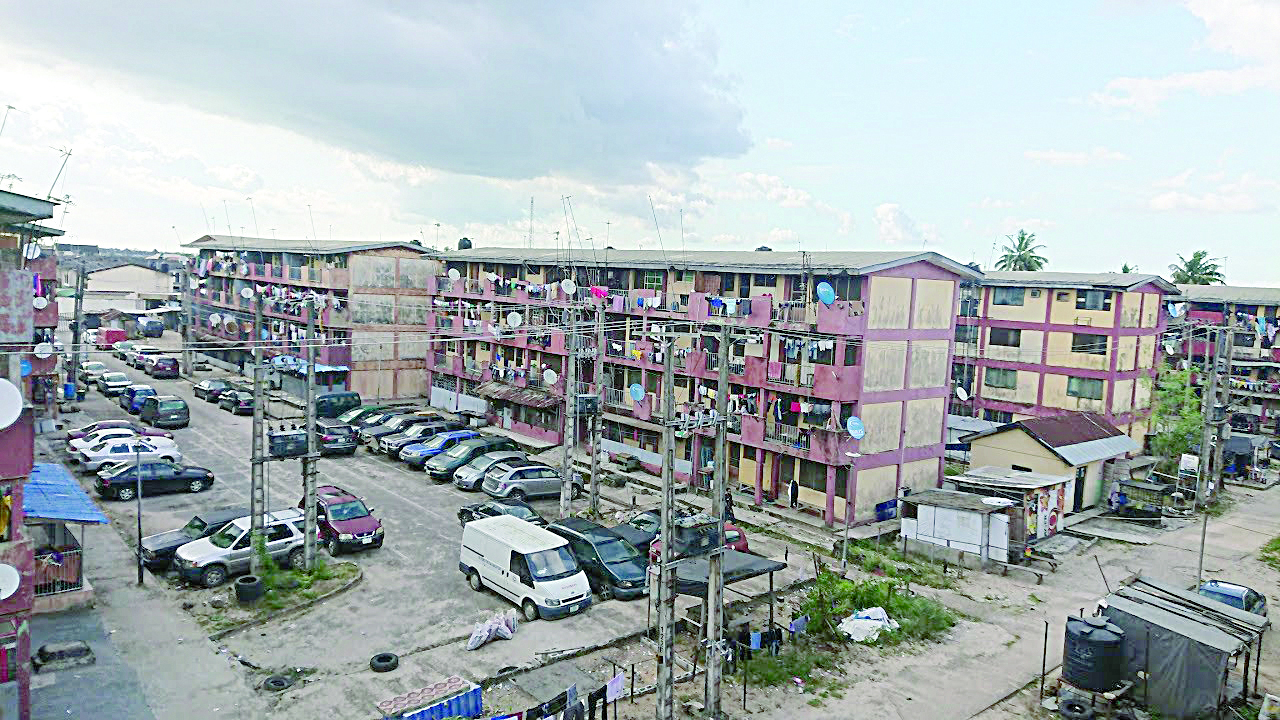
For certain reasons, including a lack of rules governing human activities, the estate is fast becoming a slum where sex workers, hoodlums, criminals and illegal immigrants, among others, operate freely amid infrastructural decay, CHIJIOKE IREMEKA writes.
Since its creation in 1977, the FESTAC Town has never been in such a nasty state it has recently found itself, where all the infrastructures that made it what it is have completely broken down, especially with numerous impassable roads in all areas of the estate.

It is a tale of an abandoned estate that was once a pride of the country. Ironically, the residents, the government and its agencies contributed to its destruction, especially the Federal Housing Authority (FHA) which sold off its buffer zone and made the estate to be prone to flooding. Also, the tripartite claims over the ownership and control of the estate among the Amuwo-Odofin Local Council where it is situated, the Lagos State government and the Federal Government have compounded problems for the estate, leading to its dilapidation.
One of the biggest problems of the estate can be explained with an Igbo adage that says ‘A goat that two or more people feed or cater for usually dies of starvation.’ It is usually the inevitable consequence because there is no clear resolution or agreement on who should be held responsible if anything goes wrong with the goat.
Till today, the local council, the state government and the Federal Government, to a certain extent, lay claim to ownership of the estate when it comes to levy or rent collection, unfortunately, none accepts the liability therein. The three tiers of government are always in conflict over which of them should collect which levy or rate, but none is accepting responsibility for the high level of dilapidation the estate has suffered and still suffering.

PHOTOS: CHIJIOKE IREMEKA
In FESTAC, various crimes, especially theft of public infrastructures, are commonly perpetrated. Stealing of manhole covers by those who disguise as metal scavengers and cart pushers is a recurring decimal in the estate. The manhole covers are meant to protect the underground drains and sewage recycling plants from being covered up by sand or garbage.
The commercialisation of the FESTAC’s buffer zone for real estate development is posing a serious threat to the existence of the estate and other facilities. The threat is palpable in the way the roads and streets in the estate are frequently flooded.
The popular Second Avenue, which is the location of the sold buffer zone, is the worst hit. The flood that ordinarily settles in the zone until it is completely absorbed now gathers on the main road, washing off the already weak tars and leaving the roads in a deplorable state.
During The Guardian’s visit to some parts of the troubled areas, it was observed that the water, which is supposed to go into the buffer zone, now found its ways to the road as a result of reclaiming of land and perimeter fencing at some spots. Landscaping prevents floodwater from flowing into the supposed buffer zone as no landlord or landlady would allow it to be channelled to his or her land.
Thus, this ever-busy road that connects FESTAC to the neighbouring communities as well as all other avenues in the estate has been deserted like many other roads that have suffered the same fate in recent times.
Motorists are paying heavily to pass through the road. The Third Avenue to 21 Road junction has been barricaded by the police to prevent rumoured planned attack on their stations by criminals. Thus, all vehicles, both heavy and light trucks, have to pass through the Third Avenue, in front of the office of the Nigeria Immigrations Service (NIS).
The abandoned Second Avenue Road is popular for collecting traffic from Okota-Ago to Apple Junction, and parts of Oshodi-Apapa Expressway, through the Second Rainbow, and channelling them to the Mile 2-Badagry Expressway, via Alakija (Festac 3rd Gate), without going through Mile 2.
It is on this road that two major police divisional headquarters, including Area E Command, are located. The FESTAC Immigration Office at the Third Avenue is usually accessed through the road. These Federal Government facilities should ordinarily attract Federal Government’s presence in the estate.
Vehicles are usually stuck in the deep gully between Agboju Market and the Police Stations road. The gully is so deep that bold pebbles are being used to fill it through community effort.
Moving towards Alakija at the end of the Second Avenue, the road was in a very bad state. Motorists have abandoned that portion and started driving against the traffic, putting serious pressure on that particular area that is begging for repair.
It was gathered that many motorists, who wouldn’t risk losing their tyres and shock absorbers to the sharp edges of the bold pebbles, find alternative routes in the inner streets, while others who do not know how to meander their ways through feeder roads would be forced to drive through the gravel.
One major accompanying consequence of this situation is traffic gridlock. The flood destroys the sand-filled roads with weak tars of over 45 years ago. It was observed that a part of the Second Avenue Road, by the Third Avenue junction to the Passport office, has turned to a ‘lake’ of dirty and stinky water. It is the same situation in other areas where such is found, breeding mosquitoes and causing environmental hazard.
The Guardian learnt that in the absence of the Federal Government in the estate, the residents are now at the mercy of refuse collectors who use debris and other domestic wastes collected from different households to fill the ditches on the roads, thereby making a mess of the bad situation.
Some of the roads like the 7th Avenue, by Mountain of Fire Church, can only be passable due to the debris and rubble used to fill the gullies. The same is applicable at the junction between 52 Road and 5Th Avenue.
The local council claims that executing road project in FESTAC will require a huge amount of money, thus it is the responsibility of the state and federal governments, although all of them collect one levy or the other and have failed to do something meaningful.
It was learnt that the local government sometimes patch the gullies on the roads, but the patches do not last six months before they start wearing off.
A former Chairman of Amuwo-Odofin, Prince Ayo Adeniji, said: “FESTAC roads are due for total resurfacing but the local government does not have the financial muscles to do so except with support from the state or federal government.”
The last major road reconstruction in FESTAC was during the administration of Babatunde Fashola as governor of Lagos State. He tarred 21 Road, 22 Road and Second Rainbow-FESTAC Bridge road, among other portions of 4th Avenue.
“There is the total absence of Federal Government in FESTAC except for creating troubles for the residents. The Federal Government, through the FHA, has sold off the buffer zones. They are not meant for sale as they are flood collection zones to ensure that the well-planned estate does not rot away,” a landlord, Mr Bolaji Adeosun, of Six Avenue told The Guardian.
According to him, the increasing road dilapidation experienced in today’s FESTAC is due to total abandonment of the estate by the Federal Government, especially selling the buffer zones on 2nd Avenue, which the owners took possession of last year and now causing serious damage to the roads.
“Since the owners of the land came in last year and started pilling the land with concrete, there has been a heavy flood on both sides of the dual carriage road. Go around, you will find a number of roads not in use due to bad condition. A portion of the Third Avenue, towards the Fourth Avenue has been like that for long,” Adeosun lamented.
He said motorists had abandoned the road and were diverting to inner roads, which would soon suffer the same fate in no distant future with heavy-duty trucks also plying the roads now.
The Guardian learnt that, apart from the bad state of the roads, the growing population of residents of the estate is putting pressure on the few remaining facilities, even as the construction of new buildings to accommodate more people is defacing the architecture.
A lawyer, Emeka Ndukwe expressed worry that the FHA was admitting more people to live in the estate without making any effort to address the issue of the infrastructural deficit. He said the overstretched underground sewage recycling plants had broken down and the influx of more people is compounding threats to life and property even as it turns the estate into a serious business community.
Located along the Lagos-Badagry Expressway, FESTAC is a Federal Housing Estate consisting of 5,000 contemporary dwelling units and seven major avenues. The town was designed in an efficient crisscross to accommodate up to 45, 000 visitors as well as Nigerian employees and officers working for the festival.
The Nigerian government invested substantial sums of money and resources in building the estate which spotted state-of-the-art electrical generators, police and fire stations, access to public transportation, supermarkets, banks, health centres, public restrooms, and postal service offices.
The ‘FESTAC Village’ was, therefore, intended to evoke the modern age and the promise of state-sponsored economic development fuelled by oil revenues.
Participants at the festival in 1977 were given accommodation in the housing units, which were, afterwards, allocated to winners who emerged through a ballot and those who purchased them during the privatisation scheme of the former administration of Gen. Olusegun Obasanjo.
This one time famous estate is being abandoned to rot away due to what observers described as confusion over its status. The federal, state and local governments all lay claim to the management of the estate and occasionally, the trio impose on the resident’s various charges, ranging from valuation fees to local government levies and tenement rates. This appeared to be the crux of FESTAC’s tale of abandonment. The maintenance of the estate has been left to the landlords and tenants. As a result, changing the estate’s architectural unison has become inevitable. It appears that there are no rules governing the estate.
All manner of criminal activities and social vices are thriving in FEASTAC today. The once purely residential estate now seems to have evolved into a heavily commercial town where many activities, legal and illegal, are thriving. FESTAC’s glorious days seem to be over as a plethora of private developers and investors have sucked the nectar of the beautiful arts village that was the toast of Lagos and Nigeria at a time.
“Car dealers are everywhere in the estate. This business has also attracted criminals and vehicle vandals to public and private houses. Oftentimes, cars parked on the streets and in private garages are vandalised and stolen,” Mr Ejiofor Johnson, one of the residents whose car was once vandalised, lamented.
There is also the menace of stench from the broken-down sewage of the overcrowded high-rise apartments.
“Because of lack of government’s presence, individual house owner tries to manage their houses the way it seemed best to them. Thus, the construction of septic tanks and drainages to evacuate their sewage becomes the order of the day. There was no provision for the construction of those facilities since the sewage is treated underground and sent to the buffer zones at Second Avenue. There is always disagreement on what should be done and that is why most of the blocks are a sorry sight. A number of them are fast developing green filamentous algae in the absence of good painting,” one of the landlords, Mr Ayo Balogun of 5th Avenue said.
Understanding that non-painting of the buildings causes microbial depreciation, the then administration of Fashola once asked residents of the different blocks of flats to paint their blocks, or else the state government would paint and make them pay for it.
The fear of being made to pay the higher cost of painting to the government spurred many of the residents to contribute money to paint their blocks of flats. While some blocks were hurriedly painted, others are still in sorry sight.
A resident, Mr Ben Aremu, said his own block has not been fully painted because some residents have not contributed money for that purpose. According to him, some tenants who felt that the money was too much for them opted to paint theirs themselves, “the reason you see different colours of paint on the same building.”
Building in unauthorised areas of the estate is another issue. “What the people do is to settle FHA not to hamper their building anywhere. Again, the recreational grounds have been converted to business centres and buildings appear on walkways. Most of the facilities placed underground are unearthed due to lack of management. The electricity wires which were also laid underground are now seen overhead,” Aremu said.
But Jerome Abraham of the FHA claimed that the housing agency was doing its work accordingly and had never been involved in underhand practices as far as FESTAC is concerned. “That is why we give approval to any new structure in the estate, including those who want to amend their houses.”
“The movement of heavy-duty vehicles has caused more troubles for the roads. It should be remembered that the land upon which the estate was built was sand-filled, as a result, the heavy vehicles are not needed in the estate, with exception to those oil tankers that come to refill the fuel stations,” 60-year old Mrs. Grace Uzoma said.
To check the damage being done to the roads in the estate, the administration of Ayo Adeniji as former chairman of Amuwo-Odofin Local Council banned the movement of heavy vehicles in the estate and allowed only oil tankers that supply fuel to the petrol stations.
To achieve this, the local government erected barrier bars across the four major gates to the estate in such a way that they could only admit cars and low ranged buses. It was done in such a way that when the oil tankers come, the task force opens the horizontal bar placed at each gate and lets them in.
“Though Adeniji tried to stop this, the effort encountered one problem or the other. On several occasions, those flat-bucket or container-carrying trailers knocked off the bar in their desperation to enter the estate to offload their products. The barriers had been knocked down many times and even the council chairman, at a point, gave up and started collecting tolls through the council workers at the gates.
“He also demolished a number of stalls on the walkways and unapproved locations, but upon payment of money, he allowed them again. As long as you have the money to spend, they are ready to allow you to do what you want.
“A typical example is the case of those women selling foodstuffs and other food vendors on the road setback and walkways on 22 Road.”
Living In FESTAC Is Addictive
However, the story of FESTAC is not about the rot alone. There are good reasons the residents do not want to leave the estate even when they have built their houses outside FESTAC.
FESTAC is touted to be one of the best places for nocturnal activities in Lagos despite its alleged high crime rate. In the estate, it’s very free to move about at night without being attacked, but that does not mean that there are no red-flag areas as it is in many communities in Lagos where residents could be robbed.
The Guardian gathered that the police are everywhere at night. At the major nightclubs, they are always there, well positioned with their vehicles.
In FESTAC, especially from Wednesday night tagged ‘ladies night’ through Sunday, one can get taxi or shuttle buses as well as commercial motorcycle operators, popularly called Okada, at any hour of the night to move from one club to the other with ease.
In fact, the robberies that took place in FESTAC were in the daytime.
Also, being touted as a ‘big boys area’, underage girls from FESTAC and from the neighbouring communities feel free to engage in the sex trade.
According to them, FESTAC ‘big boys’ pay higher than their colleagues in Ajegunle, Orile, Old Ojo road and Ojo Barracks.
“Sometimes, a night with them can fetch N15, 000 and sometimes less. But no Ajegunle guy pays as high as N10, 000 per night,” a young girl who was angry for providing such information to The Guardian without being taken home for an all-night service, Jackie, said reluctantly.






